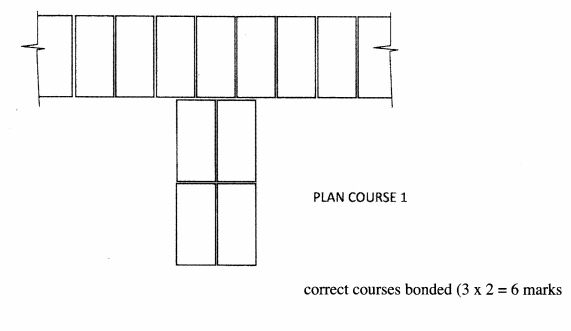2011 KCSE Building and Construction Past Paper
Building Construction Paper 1 (446/1)
SECTION A (40 marks)
Answer all the questions in this section.
1 (a) Name two setting out equipment that are used for setting out corners of buildings. (1 mark)
(b) Name two types of foundations and state the type of soil in which each may be used. (2 marks)
2 (a) State two reasons for discouraging the use of very fine aggregate in a concrete mix. (1 mark)
(b) Make a labelled elevational sketch of a three course honeycomb wall. (3 marks)
3 (a) State four functions of oversite concrete. (2 marks)
(b) Differentiate between damp proof course and damp proof membrane with respect to moisture movement. (2 marks)
4 (a) (i) Define the term scalfold. (1 mark)
(ii) Name two types of scalfolds and state one example in each case. (2 marks)
(b) Outline four factors that will influence the positioning of a pit latrine on a site. (2 marks)
5 (a) List two tools used for landscaping. (1 mark)
(b) Figure 1 shows a window sill. Name the parts labelled A, B and C, giving the function of each part. (3 marks)

6 (a) (i) State two items of safety wear worn on site. (1 mark)
(ii) Give two types of inspection which are carried out before work commences in a trench 1.5 metres deep. (2 marks)
(b) Sketch a section of a roof to show the minimum lap of iron sheets at a purlin. (2 marks)
7 (a) Sketch two sections of timber skirtings showing the treatment given to the top edges. (2 marks)
(b) Give two reasons that determine the rating of bulbs to be fitted in a room. (2 marks)
8 A kitchen floor is to receive a terrazzo finish. Describe the procedure of laying the floor finish. (3 marks)
9 Outline two functions of each of the following roof truss members: (a) rafter (2 marks)
(b) tie beam. (2 marks)
10 Using a pair of compasses and a ruler only. construct a triangle whose base length AB = 120 mm. angle CAB = 60“ and angle ABC = 45“ hence inscribe a circle touching all the sides. (4 marks)
SECTION B (60 marks)
Answer question 11 and any other three questions from this section.
Candidates are advised to spend not more than 25 minutes on question 11.
11 Figure 2 shows orthographic views of a vase drawn in first angle projection. To a scale of 1:1, draw an isometric view of the vase with point X as the lowest point.(15 marks)

(15 marks)
12 (a) With the aid of sketches, outline two methods of anchoring the sole plate of a timber wall frame on a concrete floor bed. (11 marks)
(b) Using a sketch, explain how to construct a public footpath using concrete slabs. (4 marks)
13 (a) With the aid of a labelled sketch, show the damp proofing details at a junction of a floor slab and an external wall. (6 marks)
(b) Sketch and label horizontal sections to show two methods of fixing a vertical timber cladding on a wall. (9 marks)
14 (a) Sketch and label a vertical section through a cold water storage cistern. (9 marks)
(b) With the aid of a labelled sketch, explain how a boning rod and a site rail are used to level a trench bottom. (6 marks)
15 (a) Outline the procedure of:
(i) obtaining a representative sample of sand from a large heap; (5 marks)
(ii) fixing trusses into position to form a roof. (4 marks)
(b) Sketch alternate plan courses to show the bonding details of a T-junction wall in English Bond. (6 marks)
2011 KCSE Building and Construction-Marking Scheme/Answers
SECTION A
1 (a) Tools/equipment for setting out corners:
(i) site square
(ii) builders square
(iii) dumpy level
(iv) theodolite
(Any 2 X 1/2 =1 mark)
(b) Types of foundations:
Name of foundation

(Any 2 x % = 1 mark) (Any 2 X % = 1 mark)
2 (a) Reasons for discouraging the use of fine aggregates:
(i) to reduce drying shrinkage
(ii) to check against reduced strength
(iii) to reduce the amount of cement used
(Any 2 x 1/2 = 1 mark)
(b) Honey comb Wall:
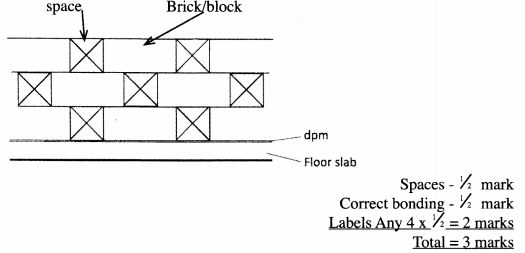
Total = 3 marks
3 (a) Functions of over site concrete:
(i) provide a firm base on which to lay floor finishes
(ii) provide a level surface
(ii) prevent growth of vegetation
(iv) prevent ingress of moisture from soils below
(v) thermal insulation
(vi) sound proofing
(Any 4 x 1/2 = 2 marks)
(b) Damp Proof Course (DPC) is used in a building to provide a barrier to the passage of moisture from an external source into the fabric of a building vertically/through the Wall
Damp Proof Membrane (DPM) is used to prevent the passage of moisture from the lower part of ground to the upper surface of the floor. (2 x 1 = 2 marks)
4. (a) Scaffolds
(i) A scaffold is a temporary structure which is erected to provide access/enable the Workers, materials and equipment get to heights which cannot be reached from the ground. (1 x 1 = 1 mark)
(ii) Independent e.g. tower, trestle (types 2 x 1/2 = 1 mark)
Dependent e.g. putlog, cantilever {example 2 X 1/2 = mark)
(Total = 3 marks)
(b) Four factors that will influence the positioning of a pit latrine on a site
(i) wind direction
(ii) slope of land
(iii) distance to Wells
(iv) Security to the users
(4 X 1/2 = 2 marks)
5. (a) Two tools used for landscaping (i) jembe
(ii) panga
(iii) rake
(iv) fork
(v) Mattock
(Any 2 X 1/2 = 1 mark)
(b) Function of parts of a window sill
A – Joggel ~ for mixing window frames and water seals
B – Slope – for shedding off water
C – Throat – for dripping off water
6 (a) (i) Items of safety wear worn on site:
(i) helmet
(ii) overall
(iii) overcoat/apron
(iv) boots
(v) muffles
(vii) goggles
(Any 2 x 1/2 = 1 marks)
(b) Types of inspection before work commences in a deep trench:
(i) collapse of the trench sides
(ii) cracks on the trench sides
(iii) timber supports to the trench sides
(iv) Water in the trench bottom
(v) leveling
(Any 2 x 1 = 2 marks)
(b)

(Total = 2 marks)
7. (a) SKIRTINGS – treatment to edges

(2 marks)
(b) Reasons for determining rating of bulbs:
(i) function of the room
(ii) decoration of the room
(iii) size of the room
(iv) size of openings in the room. (Any 2 x 1 = 2 marks)
8. Procedure of laying terrazzo:
(i) prepare the background
(ii) lay the cement-sand screed
(iii) lay the dividing strips
(iv) mix, place and compact the terrazzo
(v) grind and clean the floor finish
(3 marks)
9. Functions of roof truss members:
(a) Rafters
(i) distribute loads from roof to load bearing walls
(ii) provides the pitch for the roof
(iii) holds other members together
486 (Any 2 x 1 = 2 marks)
(b) Tie beam
(i) tying the truss
(ii) fixing of brandering and ceiling
(iii) supporting the water cistem
(iv) supporting service pipes for water and electricity
for (Any 2 x 1 = 2 marks)
10.

11.
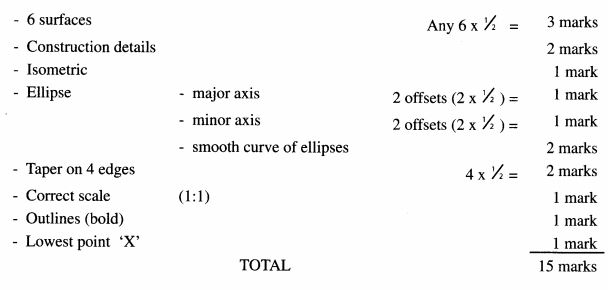

12. (a) Methods of anchoring the sole plate of a timber wall frame:
(i) using J-bolt

– mark the position of the sole plate
– cap the J-bolt in position during concreting
– mark the position of bolt on the sole plate and drill
– plug and fix sole plate with nuts
(ii) using strap/hoop irons
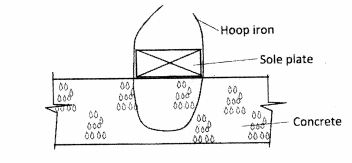
– hoop irons are cost in site during the concreting stage
— sole plate is positioned
– hoop irons are stretched and nailed onto the sole plate
(iii) using wooden plug:

– drill holes on the concrete bed to accommodate the wooden plugs
– drive wooden plugs into the holes
– position the sole plate and secure onto Wooden plugs with nails or screws
(b) Public Footpath

(i) compact the leveled natural ground
(ii) lay kerbs and drainage channel
(iii) lay and compact sand bedding to required fall
(iv) lay paving slabs
(v) fill joints With mortar
Sketch = 2 marks
Explanation = 2 marks
(Accept other appropriate sketches) = 4 marks
13. (a) Damproofing details at function of floor slabs and external wall

(b) Methods of providing vertical timber cladding

(iii) Using rebated joint
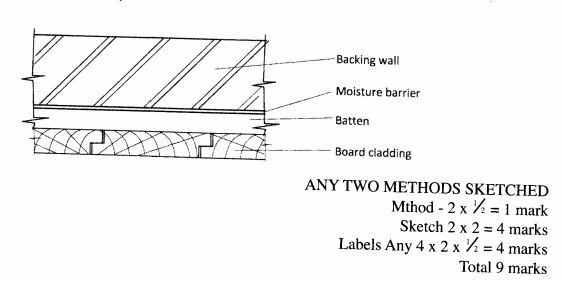
14. (a)

(b)

Explanation
(i) Establish level at sight rail
(ii) Establish level at sighting rod
(iii) Use travelling rod to establish intermediate levels
Sketching = 3 marks
Labels 3 x 1/2 = 1 1/2
Explanation — 3 x 1/2 = 1 1/2
6 marks
15. (a) Procedure of obtaining a representative sample of sand:
(i) select a large sample from a given heap and pour it on a flat surface
(ii) divide the sample into four equal parts (quarters)
(iii) select diametrically diagonally opposite quarters and reject the test
(iv) mix and pour the selected sample to form a cone
(v) repeat the quartering procedure until a representative sample is obtained (5 marks)
(b) Procedure of fixing trusses into position to form a roof:
(i) mark the position of the trusses
(ii) place the trusses in the marked positions
(iii) fix the end trusses plumb
(iv) brace the trusses
(v) tie the strings for alignment in order to align the remaining trusses into position
fix the intermediate trusses into position with appropriate braces as you maintain the plumpness
(4 marks)
(c)
